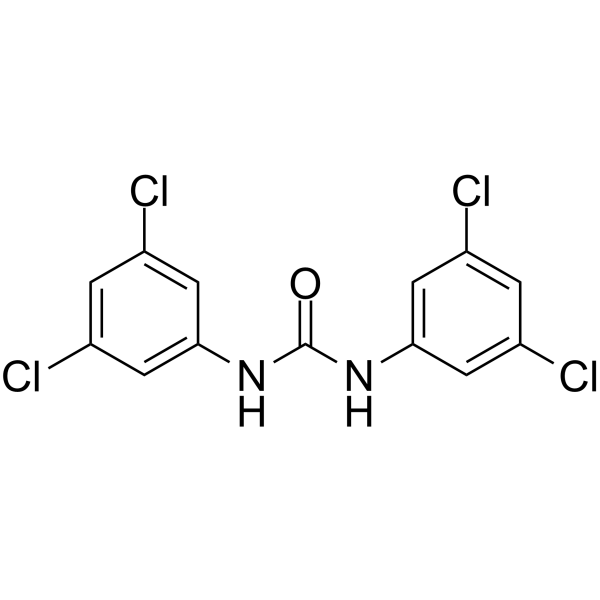Physicochemical Properties
| Molecular Formula | C13H8CL4N2O |
| Molecular Weight | 350.03 |
| Exact Mass | 347.939 |
| CAS # | 73439-19-7 |
| PubChem CID | 595311 |
| Appearance | Gray to gray purple solid powder |
| Density | 1.6±0.1 g/cm3 |
| Boiling Point | 363.2±42.0 °C at 760 mmHg |
| Melting Point | 298-300 °C |
| Flash Point | 173.5±27.9 °C |
| Vapour Pressure | 0.0±0.8 mmHg at 25°C |
| Index of Refraction | 1.706 |
| LogP | 7.01 |
| Hydrogen Bond Donor Count | 2 |
| Hydrogen Bond Acceptor Count | 1 |
| Rotatable Bond Count | 2 |
| Heavy Atom Count | 20 |
| Complexity | 294 |
| Defined Atom Stereocenter Count | 0 |
| InChi Key | VKVJIWVUYNTBEZ-UHFFFAOYSA-N |
| InChi Code | InChI=1S/C13H8Cl4N2O/c14-7-1-8(15)4-11(3-7)18-13(20)19-12-5-9(16)2-10(17)6-12/h1-6H,(H2,18,19,20) |
| Chemical Name | 1,3-bis(3,5-dichlorophenyl)urea |
| HS Tariff Code | 2934.99.9001 |
| Storage |
Powder-20°C 3 years 4°C 2 years In solvent -80°C 6 months -20°C 1 month |
| Shipping Condition | Room temperature (This product is stable at ambient temperature for a few days during ordinary shipping and time spent in Customs) |
Biological Activity
| Targets | AMPK[1] |
| ln Vitro | In 3T3-L1 preadipocytes and cancer cells like HL-60, HeLa, and MCF-7, COH-SR4 (1–5 μM; 24 hours) causes a dose-dependent increase in the phosphorylation of AMPK and its substrate ACC[1]. Significant inhibition of 3T3-L1 adipocyte differentiation is observed in a dose-dependent manner with COH-SR4 (3-5 μM; 7 days)[1]. In a 24-hour period, COH-SR4 (1–5 μM) stimulates cell G1 cycle arrest[1]. Key transcription factors associated with adipogenesis and lipogenic proteins are downregulated when COH-SR4 is present, leading to a significant reduction in intracellular lipid accumulation[1]. |
| ln Vivo | In obese mice fed a high-fat diet (HFD), COH-SR4 (5 mg/kg; ig; three times/week; for six weeks) decreases body weight and fat mass without changing food intake[2]. In HFD obese mice, COH-SR4 improves dyslipidemia and glycemic control[2]. In HFD obese mice, COH-SR4 reduces adipose tissue hypertrophy and modifies circulating adipokine levels[2]. In HFD obese mice, COH-SR4 prevents hepatic lipid accumulation and fatty liver[2]. |
| Cell Assay |
Western Blot Analysis[1] Cell Types: 3T3-L1 preadipocytes, HL-60 cells, HeLa cells, MCF-7 cells Tested Concentrations: 1 μM, 3 μM, 5 μM Incubation Duration: 24 hrs (hours) Experimental Results: Indirectly activated AMPK. Cell Cycle Analysis[1] Cell Types: 3T3-L1 cells Tested Concentrations: 1 μM, 3 μM, 5 μM Incubation Duration: 24 hrs (hours) Experimental Results: Modulated the level of proteins active during S and G2 phases of the cell cycle. |
| Animal Protocol |
Animal/Disease Models: Nine-week old male C57BL/6J mice[2] Doses: 5 mg/kg Route of Administration: po (oral gavage), three times a week, for 6 weeks Experimental Results: diminished body weight and fat mass in HFD obese mice. |
| References |
[1]. Small‑molecule COH-SR4 inhibits adipocyte differentiation via AMPK activation. Int J Mol Med. 2013 May;31(5):1166-76. [2]. COH-SR4 Reduces Body Weight, Improves Glycemic Control and Prevents Hepatic Steatosis in High Fat Diet-Induced Obese Mice. PLoS One. 2013; 8(12): e83801. |
Solubility Data
| Solubility (In Vitro) | DMSO : 125 mg/mL (357.11 mM) |
| Solubility (In Vivo) |
Solubility in Formulation 1: 2.08 mg/mL (5.94 mM) in 10% DMSO + 40% PEG300 + 5% Tween80 + 45% Saline (add these co-solvents sequentially from left to right, and one by one), suspension solution; with sonication. For example, if 1 mL of working solution is to be prepared, you can add 100 μL of 20.8 mg/mL clear DMSO stock solution to 400 μL PEG300 and mix evenly; then add 50 μL Tween-80 to the above solution and mix evenly; then add 450 μL normal saline to adjust the volume to 1 mL. Preparation of saline: Dissolve 0.9 g of sodium chloride in 100 mL ddH₂ O to obtain a clear solution. Solubility in Formulation 2: ≥ 2.08 mg/mL (5.94 mM) (saturation unknown) in 10% DMSO + 90% Corn Oil (add these co-solvents sequentially from left to right, and one by one), clear solution. For example, if 1 mL of working solution is to be prepared, you can add 100 μL of 20.8 mg/mL clear DMSO stock solution to 900 μL of corn oil and mix evenly. (Please use freshly prepared in vivo formulations for optimal results.) |
| Preparing Stock Solutions | 1 mg | 5 mg | 10 mg | |
| 1 mM | 2.8569 mL | 14.2845 mL | 28.5690 mL | |
| 5 mM | 0.5714 mL | 2.8569 mL | 5.7138 mL | |
| 10 mM | 0.2857 mL | 1.4284 mL | 2.8569 mL |
